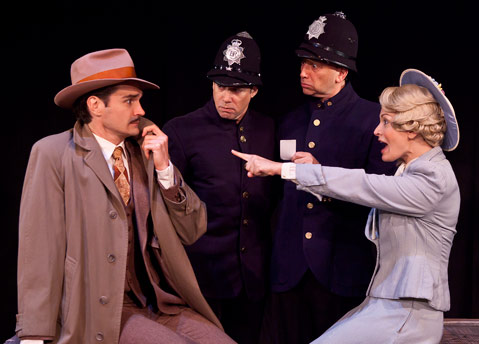The 39 Steps at Alhecama Theatre
Ensemble Theatre Company Presented a Man on the Run, in Fun on Saturday, February 4

Summary can hardly do justice to the sheer quantity of inventive theatrics that makes The 39 Steps such a great night of theater. Yes, the play takes the plot of Alfred Hitchcock’s 1935 film of the same name and turns it into a farce for four actors, and there are many lightning-fast costume changes for the two actors who must play many roles. But the real excitement of the piece lies in the imaginative ways that each individual scene finds to use simple props as the basis for satisfying and often hysterical comedy. Take the simple device of the train compartment, here rendered by the arrangement of chairs and a certain persistent self-jouncing that causes the actors to appear as though they are riding on a train. It’s a little thing, but as it lingers, the comedy builds until it comes to a boil. There’s also the device of each actor grabbing a loose bit of clothing and giving it a shake to mimic the flapping of cloth in a stiff breeze. Done once, it might be nothing remarkable, but carried on, take after take, in perfect unison and coordination across thresholds, through windows, and even onto the tops of moving trains, you have a source of howling laughter. Indeed, director Jamie Torcellini has done a marvelous job in getting this excellent cast into fighting shape for what is clearly a most demanding evening.
As Richard Hannay, the on-the-run protagonist, Matthew Floyd Miller is a hoot, offering both straight lines and witty comebacks with the same savage aplomb, and conjuring death-defying stunts, such as jumping from a moving train, out of simple benches, chairs, basic lighting effects, and physical agility. Julie Granata comes across very differently as each of the three women she plays, achieving a distinct character and profile within the first moments of her every appearance.
A great deal of the fun in this production can be put down to the antics of Christopher Shaw and Louis Lotorto, who run wild in their multiple roles as everything from Scottish innkeepers to German spies. One mad slapstick sequence spills pell-mell into another as these two wonderful clowns explore every nuance in a superbly fertile script.
None of it would work without a very good set, and Ensemble has got one, thanks to Fred Kinney’s wonderful scenic design, lighting by Michael Klaers, Elisabeth Rebel’s sound, and many, many great costumes by Marcy Froehlich.
The tradition out of which the original novel and film version of The 39 Steps arises is one of action, adventure, and above all, suspense. It begins with the great novelists of the 19th century — Zola, Dickens, Balzac — and then reaches its maturity as a genre with Arthur Conan Doyle. The play, however, only uses this suspense tradition as a jumping-off point, and it finds its true theatrical heritage in vaudeville, commedia dell’arte, and, more recently, the innovative physical theater of Théâtre de Complicité in London and the avant-garde stage effects of the Wooster Group in New York. While The 39 Steps may not aspire to the cultural impact of a Wooster production, there’s a certain fit between matter and manner that makes it more successful than many more serious productions in the same idiom. Crossing the genres of slapstick, suspense, and even love story is not easy, and the fact that this particular production is so thoroughly enjoyable testifies to the professionalism and adventurousness that we have come to expect from Ensemble Theatre Company.



